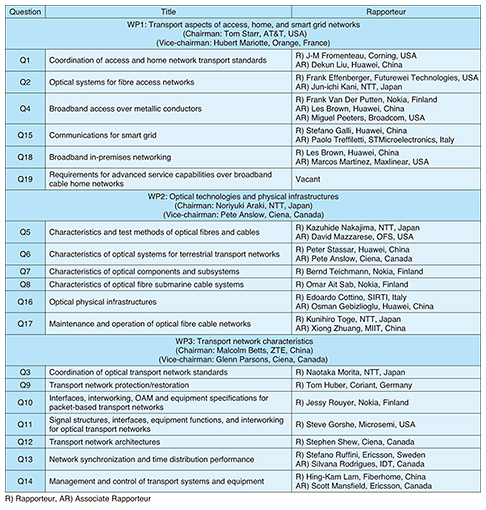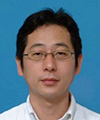 |
|
|
|
|
|
Global Standardization Activities Vol. 15, No. 12, pp. 61–66, Dec. 2017. https://doi.org/10.53829/ntr201712gls Report on ITU-T Study Group 15 MeetingAbstractITU-T (International Telecommunication Union - Telecommunication Standardization Sector) Study Group (SG) 15 was reorganized for the study period from 2017 to 2020. The new structure of SG15, which includes 3 Working Parties (WPs) and 19 Questions, has been approved. WP chairmen, vice-chairmen, and rapporteurs have been appointed. The results of the first SG15 meeting for this study period and the activity plans for the Questions are reported in this article. Keywords: ITU-T, SG15, optical technology 1. IntroductionThe International Telecommunication Union - Telecommunication Standardization Sector (ITU-T) is an organization dedicated to the international standardization of telecommunication technologies. ITU-T updates its structure every four years, which is considered to be the basic study period. This article describes the reorganization of Study Group (SG) 15 for the study period from 2017 to 2020 and the results of the group’s first meeting in this period, which was held in Geneva, Switzerland, in June 2017. 2. OrganizationThe chairmen and vice-chairmen of all SGs for the study period from 2017 to 2020 were elected at the ITU World Telecommunication Standardization Assembly held in Tunisia in October 2016. One chairman and ten vice-chairmen of SG15 were elected (Table 1). The first SG15 meeting of the new study period was held in Geneva from June 19–30, 2017. The new structure of SG15, which consists of 3 Working Parties (WPs) and 19 Questions (Qs), was approved.
3. WPs and QuestionsSG15 is one of the largest and most active SGs in ITU-T, and it covers a very wide study area that includes optical/metallic transmission media, optical physical infrastructure and transmission systems in access and core networks, and network logical layers such as packet transmission and synchronization. Formal approval was given for this SG to conduct standardization work with three WPs, just as in the previous study period. The WPs will focus on the transport aspects of access, home, and smart grid networks (WP1), optical technologies and physical infrastructure (WP2), and transport network characteristics (WP3). Although some Question titles were changed, all the original Questions from the previous study period remained unchanged except for the transfer of a Question related to home network technology from SG9 (CATV: cable television). The WP structures, WP chairmen and vice-chairmen, and the Questions and rapporteurs in SG15 are listed in Table 2.
Delegates from NTT were appointed WP2 chairman, rapporteurs of Q3, Q5, and Q17, and Q2 associate rapporteur. This indicates that NTT members will lead many of the main discussions in SG15. 4. Summary of first SG15 meetingThe first SG15 meeting was attended by 272 delegates representing 35 countries. There were more participants and countries represented than at the last SG15 meeting. Thirty delegates from Japan attended the meeting, which was the third highest number of participants after China and the United States. The meeting received 389 contributions and 482 Temporary Documents. The Japanese delegates submitted 26 contributions, the same as at the last meeting. SG15 approved 2 Recommendations, consented to 52 texts for draft Recommendations, Amendments, and Corrigenda, and agreed on 7 texts, including Supplements and Technical Reports. The main discussion results of the meeting, categorized by WP, are described below. 5. WP1: Transport aspects of access, home, and smart grid networksWP1 studies optical and metallic access systems, home networks, and smart grid networks. Q1 addresses the production and updating of standardization outlines of access and home networks and standardized work plans through information exchanges between ITU-T SGs and other standards development organizations (SDOs). Q2 examines optical access systems such as passive optical networks (PONs). In the previous study period, G.989 series Recommendations for 40-Gbit/s next-generation optical access systems (NG-PON2: Next-Generation Passive Optical Network Stage 2) were completed. At this meeting, amendments to the new Recommendation G.9807.2, which deals with 10-Gbit/s symmetric PON (XGS-PON: 10-Gigabit-capable symmetric passive optical network) and the existing Recommendation related to NG-PON2, received consent; their specifications have been expanded in accordance with carrier requirements. Progress was also made on the new Recommendation G.RoF for radio over fiber technologies with a view to receiving consent after the next meeting. Q2 members decided to start work on a supplement of 5G (fifth-generation mobile communications systems) fronthaul requirements in a PON context. Q4 deals with metallic access systems. In the previous study period, G.fast Recommendations (G.9700 series) were produced that dealt with ultrahigh-speed metallic access systems with 1-Gbit/s transmission capacity. At this meeting, progress was made on the revision of the relevant Recommendations, which included the approval of an amendment to Recommendation G.9700 with a frequency profile specification of the 212-MHz band. Q4 members also agreed to begin working on Recommendation G.mgfast (multi-Gigabit fast access to subscriber terminals) for a higher bit rate as the next-generation transceiver specification. Q15 deals with narrowband power line communication for smart grid networks. The revised Recommendation G.9901, which stipulates the output voltage level, received consent at this meeting. Q18 examines Recommendations for home networking. At this meeting, Q18 members produced amendments to G.hn series Recommendations, which include an overhaul of network authentication protocols and provisions for domain master selection. It was also agreed to start a new project on G.hn2.0 to support high-speed home networking. Q19 addresses CATV home networks. However, SG15 agreed to merge Q19 with Q18, which also studies home networking, because there was no participating delegate from SG9 and the Q19 rapporteur position is still vacant. SG15 sent a Liaison Statement to seek endorsement at the next Telecommunication Standardization Advisory Group (TSAG) meeting. 6. WP2: Optical technologies and physical infrastructureWP2 studies physical interfaces, transmission characteristics, technologies related to construction, and the maintenance and operation of outside plants in optical transport networks. At this meeting, the Technical Report of the guide to L-series Recommendations was revised with a new numbering system and the addition of new Recommendations. Q5 examines the characteristics and test methods of optical fiber and cables. In the previous study period, members made an effort to accommodate requests regarding transmission systems and therefore revised Recommendations G.652 and G.657—respectively related to conventional single-mode fiber and bending-loss insensitive single-mode fiber—in terms of wavelength dispersion characteristics. Q5 members also agreed to the expansion of the applicable areas of G.657 fiber and revised G.654 by adding a new fiber category for terrestrial coherent transmission systems. At this meeting, Recommendation G.650.3 dealing with test methods for installed optical fiber cable links was also revised. Q6 examines the characteristics of optical systems for terrestrial transport networks. After discussions on the revision of Recommendation G.698.2 related to dense wavelength division multiplex (DWDM) applications, it was agreed that the target consent date for the revised G.698.2, which includes additional 100-Gbit/s applications, will be October 2018. Existing Recommendations related to Ethernet standards and DWDM systems intended for metro (metropolitan) applications were also discussed. Q7 focuses on Recommendations related to optical subsystems and optical components. At this meeting, a new Recommendation L.404 describing a field mountable single-mode optical fiber connector received consent. This type of connector is widely used in NTT’s facilities as a FAS (field assembly small) connector and for field assembly wavelength selective terminations. Q8 focuses on optical fiber submarine cable systems. G suppl. 41, which provides a guideline for the design of optical fiber submarine cable systems, was discussed at the meeting. Q16 covers the overall optical physical infrastructure including optical fiber cables and examines Recommendations related to the characteristics of optical fiber cable systems such as optical performance and mechanical and environmental test conditions, for the purpose of promoting FTTH (fiber-to-the-home). At this meeting, Q16 members consented to new Recommendations L.110, optical fiber cable for direct surface applications, and L.202, outdoor optical cross-connect cabinet. The members also agreed to start work on standards for optical fiber cables for in-home applications. Q17 deals with the maintenance and operation of optical fiber cable networks. At this meeting, L suppl. 35 was agreed to as a framework of disaster management for network resilience and recovery. Q17 members also discussed new Recommendations related to a water detection module for underground closures and live fiber detection technology for PONs. 7. WP3: Transport network characteristicsWP3 mainly studies the logical layers of transport networks and focuses on the seven Questions described below. At this meeting, members discussed wide-ranging technologies such as packet based transport networks (e.g., Ethernet and Multi Protocol Label Switching-Transport Profile (MPLS-TP)), network architecture such as beyond 100-Gbit/s optical transport network (OTN) and transport software-defined networking (SDN), and network synchronization. Q3 members are working on coordinating effective optical transport network standards. They updated the optical transport networks and technologies standardization work plan and sent Liaison Statements to the relevant SDOs for collaboration and information exchange. Q9 examines protection and restoration technologies for transport networks. Members discuss conventional protection and restoration issues and issues related to Ethernet, MPLS-TP, and OTN. Consent was given at this meeting to two new Recommendations: G.873.3 for OTN mesh protection and G.8132 for the ring protection of MPLS-TP. Q10 examines service interfaces, OAM (operations and administration and maintenance) mechanisms, and equipment requirements for packet transport technologies of Ethernet and MPLS-TP. Consent was given to some amendments to the existing Recommendation related to the MPLS-TP interface. Q11 mainly addresses signal structures, interfaces, equipment functions, and interworking for OTN. Q11 members made progress in their discussions on over-100-Gbit/s OTN and refined the document structure of Recommendation G.709.1 to add 200/400-Gbit/s applications. Also, in a joint meeting with other relevant Question teams, members discussed the requirements of transport networks for International Mobile Telecommunication (IMT)-2020/5G because the evolution of the transport network to support IMT-2020/5G is an important new topic. The members of the joint meeting shared a common view in SG15 in regard to front/backhaul network classification, application scenarios, and the characteristics of transport networks for supporting IMT 2020/5G scenarios. These scenarios are based on discussions held by the 3rd Generation Partnership Project (3GPP). To avoid misleading the discussion, it was agreed to send a Liaison Statement to 3GPP to confirm whether the SG15 common view is correct. WP3 agreed to start work on a new Technical Report on the transport network to support IMT-2020/5G. Q12 addresses the transport network architecture for OTN and the implementation of SDN and network functions virtualization in an actual transport network. Q12 members proceeded with work on creating a Recommendation for transport SDN control architecture as the result of discussions on transport network architecture for IMT-2020/5G, SDN, and ASON (automatically switched optical network) architecture at this meeting. Q13 examines the standardization of frequency synchronization for transport networks and time and frequency synchronization for packet networks. To accommodate the increase in network traffic caused by IPs (Internet protocols) such as MPLS-TP and the requirements for IMT-2020/5G, the members of Q13 made progress on Recommendations for higher-precision time and frequency synchronization technologies. Q14 deals with Recommendations for network management and control technologies. Management requirements for general transport network elements and management requirements and an information model for specific technologies such as OTN, Ethernet, and MPLS-TP were discussed. Recommendation G.874, management aspects of OTN elements, and some amendments to the relevant Recommendations were revised at this meeting. 8. Future activitiesThe second SG15 plenary meeting in the 2017–2020 study period will be held in Geneva from January 29 to February 9, 2018. To allow sufficient discussion, SG15 has planned many interim meetings and e-meetings before that meeting. Also, an ITU-T SG15, IEEE (Institute of Electrical and Electronics Engineers) 802.3, and 802.1 joint interim meeting and joint workshop are planned for January 22–26 and January 27, 2018, respectively, just prior to the next SG15 meeting. |





